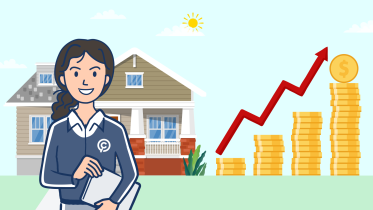- Home
- Home Loans
- Guide
- Is buying a duplex for your first home a good idea?
A Guide to buying a duplex with your first home loan
Buying a duplex as your first home is an option many people don’t even consider.
But if you buy smart, a duplex can either be a more affordable way to get the location you want, or an opportunity to become an investor at the same time you become an owner-occupier.
This guide will explain what a duplex is, how it can be advantageous to first home buyers, and where you need to be careful as there are some potential drawbacks to consider.
Key Points
A duplex is a single building containing two homes, they share a common wall and usually have the same layout. Put simply, a duplex is one house split into two; with each side often having their own entrance, yard & garage.
If a duplex building is strata-titled, the two homes are sold separately. If it is not strata-titled, it must be sold as one building with two homes.
Eligible first home buyers can use the first home owners grant to buy a duplex, but it will likely have to be a new home or a new construction to meet the criteria.
What is a duplex?
A duplex is a single building on one block of land that has been constructed as two homes.
The two homes tend to be mirror images in terms of layout, especially if they have a side by side configuration.
In a traditional duplex, the homes share a central wall.
A duplex is somewhere between a detached house and an apartment.
Each home has its own bathroom, kitchen, entrance, and driveway, but it’s not a freestanding home.
Unlike an apartment complex, you will only share a wall with one neighbour.
The two sides of a duplex usually have a similar address.
For example, one may be numbered 23a, while the other is 23b.
Compare & Save
Do you purchase one side or both sides of a duplex?
A duplex is usually built in one go, but it isn’t always sold as a single unit.
Whether you purchase one or both sides of a duplex depends on the building’s title.
If the entire structure is strata-titled, you can purchase and own one home (or side) on its own.
If the entire structure is not strata-titled, both homes must be sold in tandem.
When you own one side of a duplex, you own half of the block of land as well; when you purchase the whole building, you own the full block.
Possible duplex floor plans
Though a traditional duplex is constructed as two homes side by side, there are a few other forms that it might take.
The configuration you have could affect its rental potential and resale value.
Side by side
The standard floor plan for a duplex building includes a shared central wall, with the two homes side by side.
Since it fits most buyers’ expectations of a duplex layout, it may be easier to sell or rent.
Stacked
Less common is a duplex where each home occupies its own floor, and they share a common floor/ceiling.
Both entrances may be street-facing, but the owner of the top duplex will gain access via a set of internal stairs.
Back to front
Instead of sitting next to each other, some duplex homes are built with one behind the other.
This is the least appealing setup for buyers, as the owner or tenant of the back home often has to walk past the front home to gain access.
Can I buy a duplex with a First Home Owners Grant?
Buying a duplex as your first home is possible, but you will need to make sure you meet your state or territory’s eligibility requirements for the grant.
Most states require that the first home owners grant be used towards a new home or construction.
In some cases, a home that has been substantially renovated may meet the criteria.
This means that you likely won’t be able to purchase an existing duplex unless it has had no previous occupant.
On the other hand, you can choose to build a home off the plan or one that has been recently constructed.
This could give you a chance to customise your home or choose a layout you prefer.
If you use a first home owners grant, you’ll generally need to live in the home for at least six months before using it as a full investment property.
Why buy a duplex as your first home?
Buying a duplex as your first home can be an exciting proposition, because it offers you a few different options.
Here are some of the advantages of buying a duplex as a first home buyer.
Access a coveted location
Most first home buyers have a dream location: a suburb that they’d love to live in, if only they had the money.
A duplex can be the key to accessing that location on a first home owner budget, because half of a house comes with half of the price tag.
If you are buying the full duplex, however, this perk might not apply, as the purchase price will likely match that of freestanding homes in the area.
Save money
Even if you’re not buying in your fantasy suburb, you can still cut your budget in half by purchasing a duplex.
This could allow you to get into the housing market earlier, or allow you to take out a smaller home loan.
Again, this only applies if you are buying one home.
Rental options
When buying a strata-titled duplex, you have the option of living in one side and renting out the other.
Alternatively, you could rent out both sides and effectively get two incomes for one block of land.
This is what makes a duplex especially appealing: the opportunity to become an owner-occupier and an investor at the same time.
More privacy than apartment living
Apartments are an option for many first home buyers on a budget, but they do come with decreased privacy.
You usually won’t have your own yard, and you could have neighbours on all sides.
In a duplex, you’re only sharing with one neighbour.
Land value
With an apartment, you usually don’t own the surrounding land; with a duplex, you own the portion of the land that’s associated with your home.
This gives your purchase increased value; depending on the location it could even appreciate over time.
Less maintenance
If you own one part of the duplex, you’re basically only responsible for the upkeep on half of a house.
That means mowing half of a lawn, cleaning half of the floor space, and (hopefully) dealing with fewer repairs.
On the flip side, if you own the full building it could mean more work.
Tax breaks for investors
If you’re renting half of the home, you’ll also be able to claim tax deductions on any related expenses, such as repairs or interest payments.
Half of any shared costs—such as building insurance—can also be written off as well.
Compare & SaveDisadvantages of buying a duplex
Of course, if a duplex was all positives, everyone would be buying one!
There are some downsides to buying a duplex as your first home to consider.
Shared wall
You will share a wall and a roof with your neighbour, which gives you a few things to think about.
If you’ve got noisy neighbours, having a shared wall could drive you crazy.
If you own the whole building and rent half of it, you’ll also be sharing a wall with your tenants, which could make some people uncomfortable.
Shared building insurance
Not only do you share a wall, but you share a roof and a foundation.
If you don’t own the whole building, you’ll need to get shared building insurance with your neighbour.
You’ll also need to come together and agree on how to manage any repairs that might be necessary.
Neighbour approval for renos
Want to do renovations? You may have to get your neighbour’s approval before you do (are you sensing a theme here?).
The bottom line is, in a duplex, your neighbours matter.
If you’re renting it out, choose your tenants carefully.
If you’re planning to live in one home, you may want to meet your neighbours before moving forward.
Rental risks
There are always risks involved with renting out a property, even when it’s half a property.
If you purchase a duplex intending to rent it out, you’ll want to be confident that you can get tenants.
Tax implications
As a property investor-slash-owner-occupier, you will be able to write off certain tax deductions for the home that is rented out.
However, if you eventually go to sell the building you may be hit with capital gains tax.
This is a tax you pay on the profits from selling an investment.
Whether you’re shopping for a duplex, a standalone house, or a unit, shop around for a home loan before you purchase your first home.
A low interest rate and useful features can go a long way to helping you save money over the life of your loan.
Compare & SaveThis guide is opinion only and should not be taken as financial advice. Check with a financial professional before making any decisions.
Anthony Stevenson, is the head of home loans at Compare Club. With over a decade of experience under his belt, Anthony is dedicated to helping individuals make informed decisions when choosing a home loan. Whether it's finding the best deals on your home loan or refinancing, Anthony has a wealth of knowledge in the space.

Meet our home loans expert, Anthony Stevenson
Anthony's top home loans tips
- 1
Refinancing is the smartest, fastest way to lower your repayments and give yourself some breathing room.
- 2
There’s more to a good value home loan than just interest rates. Are you paying high account keeping fees, or being charged for making extra repayments?
- 3
Pre-approval and unconditional approval of your home loan are different parts of the same process. Our expert brokers cut through the jargon for you.
- 4
Home loan pre-approval is not compulsory. It’s possible to begin your home loan application after you’ve found the home you want to buy.


